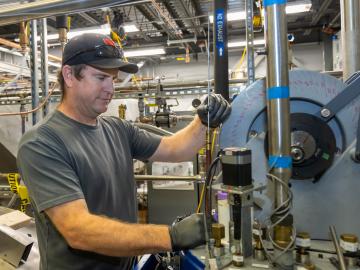Filter News
Area of Research
- Advanced Manufacturing (1)
- Biology and Environment (27)
- Clean Energy (44)
- Climate and Environmental Systems (1)
- Computational Engineering (2)
- Computer Science (5)
- Electricity and Smart Grid (2)
- Functional Materials for Energy (1)
- Fusion and Fission (21)
- Fusion Energy (7)
- Isotopes (13)
- Materials (33)
- Mathematics (1)
- National Security (11)
- Neutron Science (5)
- Nuclear Science and Technology (17)
- Nuclear Systems Modeling, Simulation and Validation (1)
- Quantum information Science (1)
- Sensors and Controls (1)
- Supercomputing (14)
News Type
News Topics
- (-) Climate Change (41)
- (-) Critical Materials (14)
- (-) Fusion (24)
- (-) Grid (30)
- (-) Isotopes (20)
- (-) Machine Learning (16)
- (-) Nuclear Energy (48)
- (-) Physics (27)
- 3-D Printing/Advanced Manufacturing (60)
- Advanced Reactors (20)
- Artificial Intelligence (24)
- Big Data (23)
- Bioenergy (36)
- Biology (44)
- Biomedical (23)
- Biotechnology (6)
- Buildings (33)
- Chemical Sciences (27)
- Clean Water (19)
- Composites (15)
- Computer Science (67)
- Coronavirus (21)
- Cybersecurity (15)
- Decarbonization (25)
- Energy Storage (61)
- Environment (93)
- Exascale Computing (6)
- Frontier (6)
- High-Performance Computing (31)
- Hydropower (8)
- Irradiation (3)
- ITER (5)
- Materials (75)
- Materials Science (65)
- Mathematics (4)
- Mercury (7)
- Microscopy (29)
- Molten Salt (6)
- Nanotechnology (30)
- National Security (25)
- Net Zero (3)
- Neutron Science (49)
- Partnerships (6)
- Polymers (18)
- Quantum Computing (7)
- Quantum Science (16)
- Security (10)
- Simulation (15)
- Software (1)
- Space Exploration (11)
- Statistics (1)
- Summit (10)
- Sustainable Energy (65)
- Transformational Challenge Reactor (1)
- Transportation (57)
Media Contacts

Associate Technician Sean Hollander is the keeper of the Fundamental Neutron Physics Beamline, which is operated by the Physics Division at the Spallation Neutron Source at ORNL, where scientists use neutrons to study all manner of matter.

ORNL scientists develop a sample holder that tumbles powdered photochemical materials within a neutron beamline — exposing more of the material to light for increased photo-activation and better photochemistry data capture.

ORNL researchers used electron-beam additive manufacturing to 3D-print the first complex, defect-free tungsten parts with complex geometries.

Mohamad Zineddin hopes to establish an interdisciplinary center of excellence for nuclear security at ORNL, combining critical infrastructure assessment and protection, risk mitigation, leadership in nuclear security, education and training, nuclear security culture and resilience strategies and techniques.

Howard Wilson explores how to accelerate the delivery of fusion energy as Fusion Pilot Plant R&D lead at ORNL. Wilson envisions a fusion hub with ORNL at the center, bringing together the lab's unique expertise and capabilities with domestic and international partnerships to realize the potential of fusion energy.

ORNL has named W. David Pointer, director of the Nuclear Energy and Fuel Cycle Division in ORNL’s Fusion and Fission Energy and Science Directorate. As director, Pointer will lead a world-class team of ORNL research professionals focused on addressing the challenges and opportunities presented by current and future nuclear energy systems.

Groundwater withdrawals are expected to peak in about one-third of the world’s basins by 2050, potentially triggering significant trade and agriculture shifts, a new analysis finds.

Forrest Hoffman, a distinguished scientist at the Department of Energy’s Oak Ridge National Laboratory, has been named a senior member of the Institute of Electrical and Electronics Engineers, the world’s largest organization for technical professionals.

Alyssa Carrell started her science career studying the tallest inhabitants in the forest, but today is focused on some of its smallest — the microbial organisms that play an outsized role in plant health.

ORNL’s Assaf Anyamba has spent his career using satellite images to determine where extreme weather may lead to vector-borne disease outbreaks. His work has helped the U.S. government better prepare for outbreaks that happen during periods of extended weather events such as El Niño and La Niña, climate patterns in the Pacific Ocean that can affect weather worldwide.




